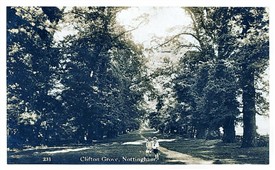Clifton Grove

Clifton Grove
Paul Nix Collection
By Joseph Earp
“Dear native grove, where’er my devious track
To thee will memory lead the wanderer back.
Still, still to thee where’er my footsteps roam,
My heart shall point, and lead the wanderer home.”
Henry Kirk White
How many people of my generation have fond memories of Clifton Grove? Perhaps as a child, you played in the woods or on the grass of the long straight drive. Building ‘dens’ among the trees, or swinging out dangerously on ropes tied to a branch. Or when you were older, you have memories of picnicking on a summer’s afternoon, or simply taking a leisurely walk, hand in hand with the one you love. Perhaps you still do these things?
“Down the Grove and Witches Steps!” is still a popular saying among Clifton folk. If you have any such memories, then you are in good company. The Grove has been a popular attraction for the people of Nottingham for well over 200 years and remains so. It seems that you can’t help waxing lyrical when writing about Clifton’s famous Grove. Can anyone tell me more about the Witch’s steps and Col. Clifton’s Pool?
So what is ‘The Grove’ and why has it attracted so much attention? In fact it is not a grove in the strict sense of the word, but a wide grass track or lane lined on both sides with trees and shrubs. The track begins on the south bank of the river Trent close to Clifton Bridge. Traveling west, it crosses the Fairham Brooke, (there was once and ancient bridge) and climbs to the top of the sandstone cliffs that here form the bank of the river. It then follows the line of these cliffs to the ‘very gates of Clifton Hall’, the whole course being around two miles. The track terminates in a large area of ‘planted’ woodland, (was this the original ‘grove’?).
The trackway must have already been a popular public walk for the folk of Nottingham. Crossing the river by the ferry at Wilford, (there was no Clifton Bridge in those days) and walking to the attraction of Clifton village had certainly become popular pass-time by the 18th century.
Clifton had its May Pole, a possible turf maze, tea shops catering for the visitors and the newly developed woodland at the hall end of the Grove. It may have been these that attracted the teenagers and young people to as one writer puts it ‘…to spend the day in merry pastimes on the village green and walking the length of Clifton Grove’. Complaints were made by villagers to local government about the ‘noise, nuisance and lateness of those returning home in the evening.’At this point, the Clifton family tried, unsuccessfully, to prevent public access to the Grove. Had it not been a public right of way, then isn’t it likely that the family would have simply gated-off their drive?
By the 19th century the Grove had become the most popular retreat from the rigours of Nottingham. Shaw’s ‘Guide to Nottingham 1874 states; ‘At Easter and Whitsuntide if the weather at all permits, thousands of Nottingham artizans with their wives and families, and young men and maidens, either with sweethearts or to gain sweethearts, flock to the Grove.’ Whatever the attractions, the Grove has always been a romantic spot and place for lovers, as attested to by the Nottinghamshire poet and native of Clifton Henry Kirk White (1783-1806). This brings me neatly to the legend of the Fair Maid of Clifton (see Fair Maid of Clifton article).
Credit:
Article by Frank E Earp. Published in the Topper Newspaper, July 20, 2011.